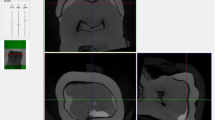Abstract
The “biogeneric tooth model” can be used for computer-aided design (CAD) of the occlusal surface of dental restorations. From digital 3D-data, it automatically retrieves a morphology matching the natural surface left after preparation. This study evaluates the potential of this method for generating well-matched and well-adjusted CAD/computer-aided manufacturing (CAM) fabricated partial crowns. Twelve models with partial crown preparations were mounted into an articulator. Partial crowns were designed with the Cerec 3D CAD software based on the biogeneric tooth model (Biog.CAD) and, for control, with a conventional data-based Cerec 3D CAD software (Conv.CAD). The design time was measured, and the naturalness of the morphology was visually assessed. The restorations were milled, cemented on the models, and the vertical discrepancy and the time for final occlusal adjustment were measured. The Biog.CAD software offered a significantly higher naturalness (up to 225 to 11 scores) and was significantly faster by 251 (±78) s in designing partial crowns (p < 0.01) compared to Conv.CAD software. Vertical discrepancy, 0.52 (±0.28) mm for Conv.CAD and 0.46 (±0.19) mm for Biog.CAD, and occlusal adjustment time, 118 (±132) s for Conv.CAD and 102 (±77) s for Biog.CAD, did not differ significantly. In conclusion, the biogeneric tooth model is able to generate occlusal morphology of partial crowns in a fully automated process with higher naturalness compared to conventional interactive CAD software.






Similar content being viewed by others
References
Neff P (1995) Trauma from occlusion. Restorative concerns. Dent Clin North Am 39:335–354
Türp JC, Greene CS, Strub JR (2008) Dental occlusion: a critical reflection on past, present and future concepts. J Oral Rehabil 35:446–453
Parker MW (1993) The significance of occlusion in restorative dentistry. Dent Clin North Am 37:341–351
Gher ME (1998) Changing concepts. The effects of occlusion on periodontitis. Dent Clin North Am 42:285–299
Dawson PE (1989) Occlusal therapy. In: Dawson PE (ed) Evaluation, diagnosis, and treatment of occlusal problems. The C.V. Mosby Company, St. Louis, pp 14–17
Christensen GJ (2004) Is occlusion becoming more confusing? A plea for simplicity. J Am Dent Assoc 135:767–770
Mörmann WH, Brandestini M (1989) Die Cerec computer reconstruction: inlays. Onlays und Veneers, Quintessenz, Berlin
Mattiola A, Mörmann WH, Lutz F (1995) The computer-generated occlusion of Cerec-2 inlays and onlays. Schweiz Monatsschr Zahnmed 105:1284–1290
Jedynakiewicz NM, Martin N (2001) Functionally generated pathway theory, application and development in Cerec restorations. Int J Comput Dent 4:25–36
De Nisco S, Mörmann WH (1996) Computer-generated occlusion of Cerec2 inlays and overlays. In: Mörmann WH (ed) Cad/Cim in aesthetic dentistry, Cerec 10 year anniversary symposium. Quintessence, Berlin, pp 391–407
Fasbinder DJ (2006) Clinical performance of chairside Cad/Cam restorations. J Am Dent Assoc 137(Suppl):22S–31S
Hartung F, Kordass B (2006) Comparison of the contact surface pattern between virtual and milled Cerec 3D full-ceramic crowns. Int J Comput Dent 9:129–136
Reich S, Troeltzsch M, Denekas WM (2004) Generation of functional Cerec 3D occlusal surfaces: a comparison of two production methods relevant in practice. Int J Comput Dent 7:229–238
Reich S, Wichmann M, Burgel P (2005) The self-adjusting crown (Sac). Int J Comput Dent 8:47–58
Mehl A, Blanz V, Hickel R (2005) Biogeneric tooth: a new mathematical representation for tooth morphology in lower first molars. Eur J Oral Sci 113:333–340
Mehl A, Blanz V (2005) New procedure for fully automatic occlusal surface reconstruction by means of a biogeneric tooth model. Int J Comput Dent 8(1):13–25
Mörmann WH (2006) The evolution of the Cerec system. J Am Dent Assoc 137(Suppl):7S–13S
Richter J, Mehl A (2006) Evaluation for the fully automatic inlay reconstruction by means of the biogeneric tooth model. Int J Comput Dent 9:101–111
Dunn M (2007) Biogeneric and user-friendly: the Cerec 3D software upgrade V3.00. Int J Comput Dent 10:109–117
Morin MR (2006) Preparation, fabrication and 3D scanning to achieve esthetic results with chairside Cad/Cam technology. In: Mörmann WH (ed) State of the art Cad/Cam restorations: 20 years of Cerec. Quintessence, Berlin, pp 92–98
Hansen S (2000) Preparations for Cerec 3: where are the limits. Int J Comput Dent 3:197–205
Cerec Team (2008) Cerec 3D preparations guidelines. Sirona - The Dental Company, Bensheim. http://www.sirona.com/ecomaXL/get_blob.php?name=cerec_3d_preparation_guidelines_en.pdf. Accessed 30 April 2009
Reiss B (2007) Cerec standard 3-D occlusal contouring in comparison with the new biogeneric occlusal morphing: a case report. Int J Comput Dent 10:69–75
Reiss B (2003) Occlusal surface design with Cerec 3D. Int J Comput Dent 6:333–342
Bortz J, Lienert GA, Boehnke K (2000) Verteilungsfreie Methoden in Der Biostatistik. Springer, Berlin p, 929
Fleiss JL (1981) The measurement of interrater agreement. In: Fleiss JL, Levin B, Paik MC (eds) Statistical methods for rates and proportions. Wiley, New York, p 321
Reich SM, Peltz ID, Wichmann M, Estafan DJ (2005) A comparative study of two Cerec software systems in evaluating manufacturing time and accuracy of restorations. Gen Dent 53:195–198
Wurbs M, Simon JF, Troeltzsch M, Denekas T, Wichmann M, Reich S (2006) Dentist-time expenditure for two different adhesive all-ceramic systems. J Dent 34:450–453
Mehl A, Blanz V, Hickel R (2005) A new mathematical process for the calculation of average forms of teeth. J Prosthet Dent 94:561–566
Fasbinder DJ (2006) Predictable Cerec occlusal relationships. In: Mörmann WH (ed) State of the art of Cad/Cam restorations, 20 years of Cerec. Quintessenz, Berlin, pp 93–100
Addi S, Hedayati-Khams A, Poya A, Sjogren G (2002) Interface gap size of manually and Cad/Cam-manufactured ceramic inlays/onlays in vitro. J Dent 30:53–58
Sjogren G (1995) Marginal and internal fit of four different types of ceramic inlays after luting. An in vitro study Acta Odontol Scand 53:24–28
Müller H (2006) FGP technique with Cerec 3D. Int J Comput Dent 9:333–338
Conflict of interest
The authors declare that they have no conflict of interest.
Author information
Authors and Affiliations
Corresponding author
Rights and permissions
About this article
Cite this article
Ender, A., Mörmann, W.H. & Mehl, A. Efficiency of a mathematical model in generating CAD/CAM-partial crowns with natural tooth morphology. Clin Oral Invest 15, 283–289 (2011). https://doi.org/10.1007/s00784-010-0384-z
Received:
Accepted:
Published:
Issue Date:
DOI: https://doi.org/10.1007/s00784-010-0384-z




